All photos by Roberto Motta
Roberto Motta has been to the Alfa Museum hundreds of times; here he discusses the impressive new museum and the differences between the old and the new. Alfa Road cars are featured, click here to see the Alfa Race Cars. Text in Italian below the photos. Ed.
On June 24, with the launch of the new Alfa Romeo Giulia and to celebrate its 105 years, Alfa Romeo inaugurated its new Museum.
Renamed “The Time Machine – Alfa Romeo Historical Museum”, it is the heart of the Alfa Romeo brand and opened its doors to the public June 30, 2015.
The original Alfa Romeo Museum was opened in 1976. It was free of charge and by reservation only. Nevertheless, about 25,000 enthusiasts came each year. But following the divestment of the museum site, the Museum closed in 2011. There appeared to be some concerns about the future location and status of the cars; thanks to the 2013 intervention of the Ministry of Heritage and Culture, the cars and the Centre Documentation would be preserved at the same location. Restoration work began in the summer of 2014, and in less than 12 months a major redevelopment built by Fiat Chrysler Automobiles was completed.
In addition to hosting some of the most significant pieces of the Alfa Romeo collection, the museum hosts other services as bookshop, café and documentation center, test track, event space.
A theme of the project is represented by a red line that runs through the entire complex; “Alfa red” tape greets visitors in the parking lot and guides them to the beginning of the museum.
Museum which is divided into six branches, and includes 69 models that marked the history of the brand. (By contrast, the old structure housed 250 cars.)
The exhibition explains to the visitors the essence of the Alfa Romeo brand, which is condensed into three basic principles: Timeline, which represents industrial continuity; Beauty, which combines style and design; and Speed, the synthesis of technology and lightness. Each principle corresponds to a floor of the museum.
Timeline
It occupies the first floor, and is home to a selection of 19 cars most representative of the evolution of the marque, each accompanied by a short informational multimedia panel.
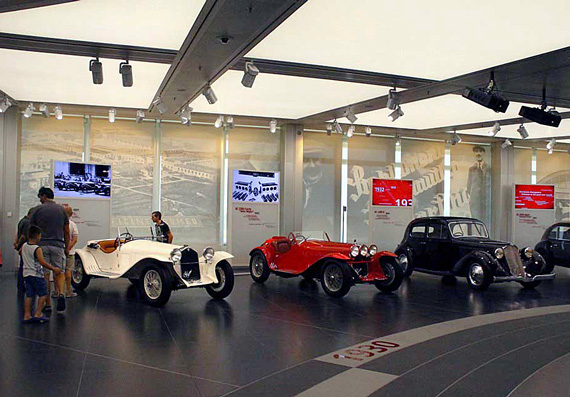
The exhibition is complemented by an “interactive memory”, which allows you to delve into the history of the models and how the Alfa Romeo has become a legend, thanks to the work of thousands of men who worked with passion.
Beauty
It occupies the entire ground “zero” with different subject areas. The exhibition takes up the designs of the great Italian coachbuilders: from “The Style Masters”, which covers 9 examples of the greatest designs of all time. “The Italian School” is an exhibition of the Alfas produced in the ’30s and ’40s with bodies by Touring Superleggera.
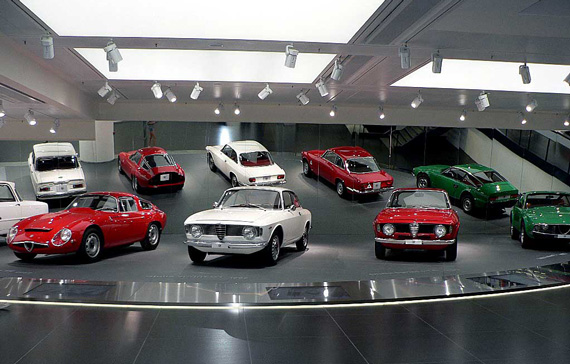
At the center of the path is “Alfa Romeo in Film” followed by “The Giulietta Phenomenon” and “Giulia: designed by the wind”, with models that have accompanied economic growth and the taste of Italy in the ’50s and ’60s.
Speed
This occupies the entire basement. This is the area where, in the old museum in addition to racing cars, there were also displayed hundreds of awards won by Alfa Romeo drivers in the various competitions.
This is the most emotional, passionate area, where the protagonists of the great victories Alfa Romeo are encountered. The “Birth of the Legend”, is a multimedia space that brings together the stars of the competition between the two world wars, to its debut in F1 and on to the wonderful “Project 33” and “Racing in the DNA.”
One then enters the “Temple of Victories”, where a show of images, sounds, and movies tell the 10 greatest triumphs in the history of Alfa Romeo. The journey ends with “emotional bubbles”, a series of stations, which thanks to a viewer and virtual reality 360 ° allows the viewer to experience a ride on the Balocco test track with different Alfa Romeo models.
We can say we were pleasantly surprised at how the museum allows the enthusiast full access to see the cars, and especially to photograph them, thanks to a well-focused exhibition and intelligent display.
What is missing?
To people like me who have visited the ‘old’ Museum hundreds of times, there remains a small vein of sadness. We do not see displays of cars like the 177, the return of Alfa Romeo cars to modern F1, or the cars that took part in the American CART series. Also missing are the 75 winners of the Tour of Italy, the 164 ProCar, the SEO48, the dream that never made only one lap, the promotional formulas such as the ‘Alfasud Trophy’ or the ‘Alfa Boxer’, and many others.
For now I’ll settle for these wonderful cars in the hundreds of images taken in the old museum, but I’d see them displayed again, because even the most common Dauphine or impractical Arna have all been part of a wonderful story, the story of Alfa Romeo and our Italian heritage.
Maybe my sadness comes from the fact that many years ago I saw the museum through the eyes of a child, and that perhaps, given my chronological age, I too am now a museum piece.
Leaving personal feelings aside, I consider the “The Time Machine – Alfa Romeo Historical Museum” one of the most beautiful car museums in the world, and one that can boast of having in their exhibition only original cars; no ‘replicas’. If you find yourself in the vicinity of Milan, well worth a visit … it will fulfill a dream.
>
Information
The Arese Museum, is open every day of the week except Tuesday.
The opening hours, 10: 00-18: 00, is extended until 22:00 on Thursday.
The price of the ticket is 12 €, reduced costs 8 Euros, while the visit is free for children under 5 years old, accompanying a disabled person and tourist guides.
To get there by car from Milan take the A8-A9 motorway exit Arese-Lainate.
For more information, visit
www.museoalfaromeo.com
LA MACCHINA DEL TEMPO – MUSEO STORICO ALFA ROMEO
Testo e foto di Roberto Motta
Lo scorso 24 giugno, in occasione della presentazione della Alfa Romeo Giulia, e per festeggiare i suoi 105 anni, la Alfa Romeo ha inaugurato il nuovo Museo.
Ribatezzato “La macchina del tempo – Museo storico Alfa Romeo”, è il cuore del marchio del Biscione ed ha aperto i battenti al pubblico il 30 giugno 2015.
Ricordiamo che il ‘vecchio’ Museo era stato inaugurato nel ’76, ed era visitabile, gratuitamente, solo su prenotazione. Ciò nonostante ogni anno garantiva circa 25000 visitatori, poi, in seguito alla dismissione del sito produttivo il museo e il centro direzionale, vennero chiusi nel 2011.
Dopo alcune vicende che sembravano mettere a rischio il museo e le macchine in esso conservate, grazie all’intervento del Ministero per i Beni e le Attività Culturali, che mise sotto tutela l’insieme del Museo, le vetture in esso contenute e il Centro di Documentazione, nel 2013 prese il via la progettazione del nuovo sito.
I lavori di restauro sono iniziati nell’estate 2014, e in meno di 12 mesi è stato completato un importante intervento di riqualificazione realizzato dalla FCA Partecipazione.
Oltre ad ospitare alcuni dei pezzi più significativi della Collezione Alfa Romeo, costituita a partire dalla prima metà degli anni ’60, il Museo ospita altri servizi come bookshop, caffetteria e centro documentazione, pista prove, spazi per eventi.
L’elemento chiave del progetto è rappresentato da una linea rossa che attraversa tutto il complesso; un nastro “rosso Alfa”che accoglie i visitatori nell’ampio parcheggio e li guida fino all’inizio del percorso museale.Percorso museale che è suddiviso su sei semi piani, e comprende 69 modelli che hanno segnato la storia del marchio. Ricordiamo che la vecchia struttura ospitava ben 250 vetture.
L’esposizione narra al visitatore l’essenza del marchio Alfa Romeo, che è condensata in tre principi di base: la Timeline, che rappresenta la continuità industriale; la Bellezza, che unisce stile e design e la Velocità, sintesi di tecnologia e leggerezza.
A ogni principio corrisponde un piano del Museo.
La Timeline
Occupa il piano 1, e ospita una selezione delle 19 auto più rappresentative dell’evoluzione del marchio, ciascuna accompagnata da un breve pannello informativo multimediale.
L’esposizione è completata da una “memoria interattiva”, che consente di approfondire la storia dei modelli e di come l’Alfa Romeo sia diventata un mito grazie al lavoro di migliaia di uomini che hanno lavorato con passione.
La Bellezza
Occupa l’intero piano “zero” con diverse aree tematiche. L’allestimento riprende le linee tracciate dai grandi carrozzieri italiani: da “I maestri dello stile”, che contempla 9 esempi di design di ogni epoca, a “La scuola italiana”, dove sono esposte le auto realizzate negli anni ’30 e ’40 dalla carrozzeria Touring con il marchio Superleggera.
Al centro del percorso “Alfa Romeo nel cinema”. Seguono “Il Fenomeno Giulietta” e “Giulia: disegnata dal vento”, con quei modelli che hanno accompagnato la crescita economica e del gusto dell’Italia degli anni ’50 e ’60.
La Velocità
Occupa l’intero piano interrato. Questa è l’area in cui, nel vecchio museo, oltre alle vetture da competizione erano raccolte anche centinaia di premi vinti dai piloti Alfa Romeo nelle varie competizioni.
È l’area più emozionale, dove l’appassionato incontra le protagoniste delle grandi vittorie Alfa Romeo: da “Nasce la leggenda”, uno spazio multimediale che riunisce le protagoniste delle competizioni tra le due guerre mondiali, fino all’esordio nella F1, al meraviglioso “Progetto 33” e “Le corse nel DNA”.
Si entra quindi nel “Tempio delle vittorie”, dove uno spettacolo di immagini, suoni e filmati raccontano i 10 più grandi trionfi della storia Alfa Romeo.
Il viaggio nel modo Alfa Romeo termina con le “bolle emozionali”, una serie di postazioni che consente, grazie ad un visore e alla realtà virtuale a 360° di vivere l’esperienza di un giro sulla pista prova del Balocco a bordo di diversi modelli Alfa Romeo.
Quindi è possibile immergersi in un viaggio temporale, vissuto attraverso la proiezione di filmati 4D dedicati ai leggendari successi Alfa.
Terminata la visita, possiamo dire di essere stati piacevolmente sorpresi da come il museo consenta all’appassionato più esigente di vedere le vetture, e soprattutto di fotografarle, grazie a una scelta espositiva mirata e ben riuscita.
A chi come me aveva visitato centinaia di volte il ‘vecchio’ Museo, rimane una piccola vena tristezza, dovuta al non vedere esposte vetture come la 177, monoposto del ritorno dell’Alfa Romeo nella F1 moderna, o le monoposto che hanno partecipato alle gara americane CART, oltre alla 75 vincitrice del Giro Automobilistico d’Italia, la 164ProCar o il sogno che non fece mai un solo giro di pista, laSE048, le Formule promozionali come ‘AlfaSud Trofeo’ o la monoposto ‘Alfa Boxer’, e molte altre ancora.
Per ora mi accontento de rivedere queste meravigliose auto nelle centinaia di immagini scattate nel vecchio Museo, ma mi piacerebbe rivederle esposte, perché anche le più bruttine coma la Dauphine o la improponibile Arna, hanno tutte fatto parte di una storia meravigliosa, la storia dell’Alfa Romeo e della nostra Italia.
Forse la mia tristezza nasce dal fatto che questa volta non ho rivisto il museo con gli occhi di un bambino, e che forse, data l’età anagrafica, sono pure io un pezzo da museo.
Lasciate le sensazioni personali, ritengo che la “La macchina del tempo – Museo storico Alfa Romeo” sia uno dei musei di marca più belli al mondo, e che può vantare di avere in esposizioni solo vetture ‘originali’ e nessuna ‘replica’.
Se vi trovate nelle vicinanze di Milano, vale la pena visitarlo…vi farà sognare.
Informazioni
Il Museo di Arese, che comprende uno showroom per la consegna delle vetture, oltre a spazi commerciali dedicati al ristoro e al merchandising, è visitabile tutti i giorni della settimana, eccetto il martedì.
L’orario di apertura, 10:00-18:00, è prolungato fino alle 22:00 il giovedì.
Il prezzo del biglietto intero è di 12 euro, il ridotto costa 8 euro, mentre la visita è gratuita per bambini sotto i 5 anni, accompagnatori di persone disabili e guide turistiche.
Per raggiungerlo in auto da Milano percorrere l’Autostrada A8-A9 fino all’uscita Arese-Lainate.
Per maggiori informazioni consultate il sito
www.museoalfaromeo.com
![]()
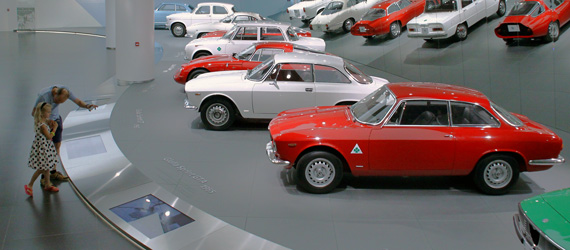

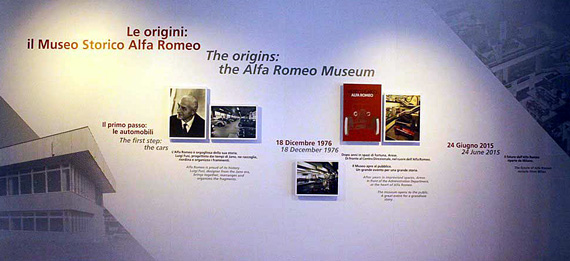
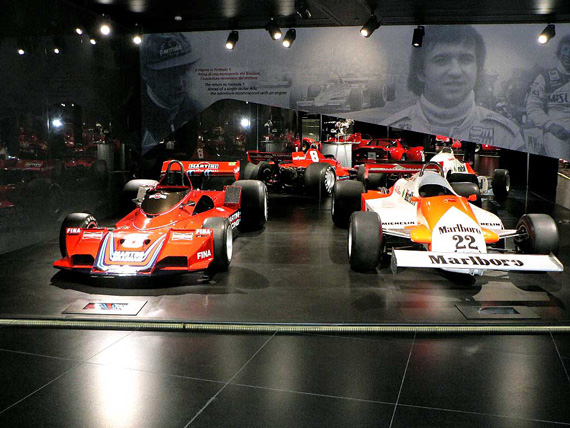
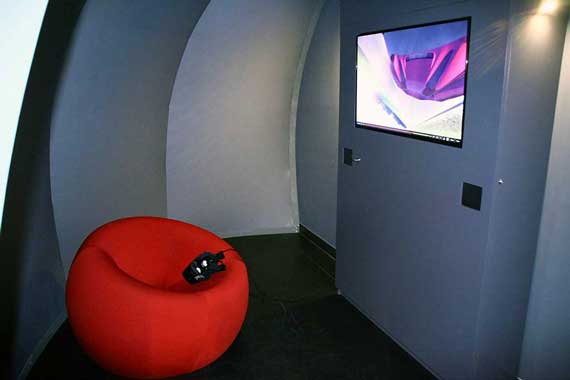
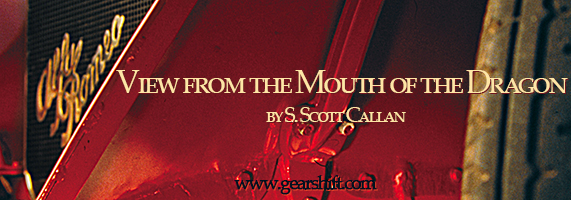
Having seen the original Museum almost ten years ago, I share the author’s reluctance to fully accept the new one. I wonder, for example, where the remaining 150 or so cars are? But, one must admit, the original museum did not present a coherent path along which to travel to really appreciate the marvelous cars housed there.
I also wonder what happened or will happen to the adjoining Arese factory, a vast modernist expanse degenerating into ruin a decade ago.
Finally, Alfa might consider a European-delivery program for its rejuvenated US franchise–with car pickups at the Museum.
I can answer part of the question above having visited Arese a few months ago. The state of the Alfa buildings then was not particularly good. In particular, the Ignazio Gardella designed office building is now a dusty, moldy mess with a lot of water damage. The former management complex where the museum is housed is in the shadow of a lot of overgrown vegetation, so it was more difficult to access. The former assembly halls now have a dark soot covered look about them. The big Alfa Romeo sign on the roof is long gone, although part of the complex is actively being used by a freight company called Cargolog.
We have to live with the “new” approach to car museums managed by young brand managers totally unaware of history and tradition: see the awful display of the racing cars of the Thirties. Also we have to survive the invasion of digital supports carrying along the ignorance implicit in tweets and scripts shorter than two lines. But please do not say that every car in the Museum is original. Everybody knows that there are replicas, indeed very good, made under Luigi Fusi for the “old” Museum in the Seventies: e.g., the Alfa Ricotti, the Bimotore, the Type A, the 512 (not the one on display, which belongs to the Milan Science & Technology Museum).
Aldo,
Thanks for your informative input; it is always much appreciated.
The word ‘original’ as used by Roberto (translated from Italian) was meant to imply that the cars were original from Alfa Romeo,i.e. not reconstructed elsewhere. I know and Roberto knows very well that the factory recreated the Bimotore and others. I should have been more specific in the translation, but I all too often assume that most of our readers know as much as Roberto, you and I do about the subject.
Editor